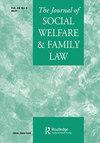“每个人都是某人的孩子”:父母对成年人的命令
IF 0.6
Q2 LAW
引用次数: 0
摘要
在X v Z【2022】EWFC 26案中,根据《2008年人类受精和胚胎学法》第54条,就1998年进行的代孕安排授予了父母命令,这意味着在申请和做出命令时,所涉及的“孩子”都是成年人。这代表了一个需要司法考虑的新问题,该判决提供了惊人的证据,证明父母命令的法定条件“在多大程度上被拉伸到了极限”,或根本无法适用”(联合咨询文件,2019,第11.2段)。X夫妇于1998年通过加州的一家机构与Z女士达成代孕协议,Y因此出生(第1段)。他们是Y的亲生父母,因为他们的两个配子都被用来制造Z夫人携带的胚胎(第10段)。按照相关的出生前法律程序,根据加利福尼亚州法律宣布X夫妇为Y的合法父母(第12段),并为Y提供了美国护照,允许他们一家在Y几天大时返回英国(第13段)。这对夫妇完全不知道在英国需要父母令才能转移合法父母身份,也没有提出任何申请(第17段)。值得注意的是,这一立场一直持续到2021年9月,Z女士联系了X女士,Z女士最近获悉了父母命令程序(第16段)。X女士寻求法律咨询,并于2021年12月提出申请,当时Y 23岁。申请人面临的明显困难是,第54(3)条规定:“申请人必须在孩子出生之日起的6个月内申请该命令”。然而,众所周知,由于James Munby P爵士在Re X(A Child)(父母令:时限)[2014]EWHC 3135(Fam)中的判决,[2015]1 FLR 349父母令可用于六个月后提出的申请,其中A v C[2016]EWFC 42,[2017]2 FLR 101中的一对13岁和12岁双胞胎是之前批准命令的年龄最大的儿童。在X诉Z案中,法院面临的问题是,这一推理是否仅限于在儿童18岁生日之前提出的父母令申请,就像2002年《收养和儿童法》第49(4)条规定的收养令一样。最终,Theis J批准了父母令(第57段),并表示:“根据我的判断,Y现在已经成年这一事实并不妨碍法院做出该命令”(第55段)。判决强调了事实背景,指出“Z先生和夫人本文章由计算机程序翻译,如有差异,请以英文原文为准。
‘Everyone remains the child of someone’: a parental order for an adult
In X v Z [2022] EWFC 26 a parental order was granted under section 54 Human Fertilisation and Embryology Act 2008 regarding a surrogacy arrangement undertaken in 1998, meaning that the ‘child’ involved was an adult at the time of both the application and the making of the order. This represented a novel issue for judicial consideration, and the judgment provides striking evidence of the extent to which the statutory conditions for parental orders ‘are being stretched to their limits, or simply cannot be applied’ (Joint Consultation Paper, 2019, para. 11.2). Mr and Mrs X undertook a surrogacy arrangement with Mrs Z through a Californian agency in 1998 and Y was born as result (para. 1). They are Y’s biological parents, since both of their gametes were used to create the embryo that was carried by Mrs Z (para. 10). The relevant pre-birth legal process was followed declaring Mr and Mrs X as Y’s legal parents under Californian law (para. 12) and a US passport was secured for Y, allowing the family to return to the UK when Y was a few days old (para. 13). The couple were entirely unaware of the requirement for a parental order to transfer legal parenthood in the UK and no application was made (para. 17). Quite remarkably, this position remained until September 2021, when Mrs X was contacted by Mrs Z who had recently been informed of the parental order process (para. 16). Mrs X sought legal advice and the application was made in December 2021, when Y was 23 years old. The apparent difficulty for the applicants is that section 54(3) provides: ‘the applicants must apply for the order during the period of 6 months beginning with the day on which the child is born’. However, as is now well known, since Sir James Munby P’s judgment in Re X (A Child) (Parental Order: Time Limit) [2014] EWHC 3135 (Fam), [2015] 1 FLR 349 parental orders can be granted for applications made after six months, with a 13-year-old and 12-year-old twins in A v C [2016] EWFC 42, [2017] 2 FLR 101 being the oldest children where orders had been previously granted. The question for the court in X v Z was whether this reasoning was limited to parental order applications raised prior to the child’s eighteenth birthday, as is the case for adoption orders under section 49(4) Adoption and Children Act 2002. Ultimately, Theis J granted the parental order (para. 57), stating: ‘[t]he fact that Y is now an adult does not, in my judgment, preclude the court from making the order’ (para. 55). The judgment emphasises the factual background, observing that ‘Mr and Mrs Z’s
求助全文
通过发布文献求助,成功后即可免费获取论文全文。
去求助
来源期刊
CiteScore
2.00
自引率
13.30%
发文量
52
期刊介绍:
The Journal of Social Welfare & Family Law is concerned with social and family law and policy in a UK, European and international context. The policy of the Editors and of the Editorial Board is to provide an interdisciplinary forum to which academics and professionals working in the social welfare and related fields may turn for guidance, comment and informed debate. Features: •Articles •Cases •European Section •Current Development •Ombudsman"s Section •Book Reviews

 求助内容:
求助内容: 应助结果提醒方式:
应助结果提醒方式:


